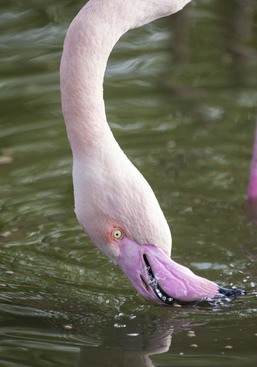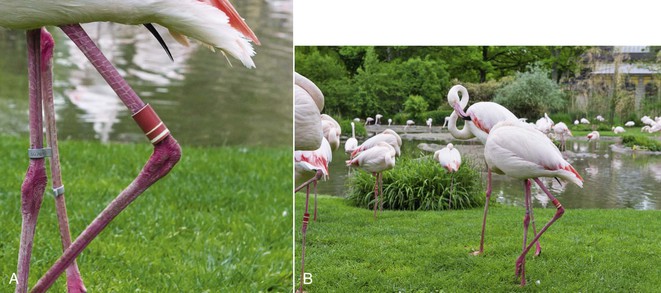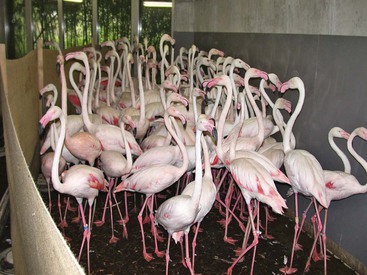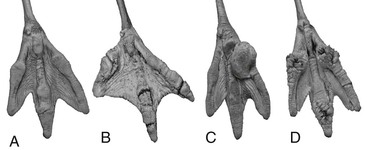Fabia S. Wyss, Christian J. Wenker Flamingos are popular zoo birds because of their elegance and brilliant coloration. They are closely related to grebes (Podicipediformes)15 and currently divided into six different species, belonging to three genera (Phoenicopterus, Phoenicoparrus, Phoeniconaias) within the family Phoenicopteridae (Table 14-1). These birds live in large colonies and are adapted to extreme habitats, for example, lakes with high salinity and alkalinity where no other vertebrates could survive. Flamingos are among the longest-lived bird species, and captive individuals in zoos may reach a lifespan of up to 70 years.45 All flamingo species are highly nomadic when searching for feeding and nesting sites, but movement patterns vary individually, temporally, and spatially among subpopulations and reflect adaptation to varying water levels and food availability.5,39 TABLE 14-1 Biologic Information about Flamingos A.s.l, Above sea level. Figure 1 courtesy Zoo Basel; Figure 2 courtesy Dace Vitola; Figures 3, 5, and 6 coursey Omar Rocha; and Figure 4 courtesy Fabia Wyss. The plumage color is caused by carotenoids (canthaxanthin, astaxanthin, and phoenicoxanthin) found in algae, crustaceans, and mollusks. After 4 to 6 years, greater flamingos display their adult plumage and turn from gray-brown to pink, which is a sign of sexual maturity.20 Preen oils containing carotenoids are excreted by the uropygial gland and are applied as additional cosmetic coloration of the feathers.3 The flamingo’s neck is proportionally the longest in birds and has 17 cervical vertebrae.11 Flamingos regulate their body temperature by resting on one or both legs,6 in different water depths, or both. Sex determination may be performed using polymerase chain reaction (PCR) of feather bulbs by isolating deoxyribonucleic acid (DNA) of the CHD-W and CHD-Z genes (females) or the CHD-Z genes only (males).7 Tarsometatarsal length rather than simple size is a tool for sex determination in Caribbean, greater, and Chilean flamingos older than 1.5 years, with males having larger tarsometatarsi.46 Flamingos are divided into two groups according to their diets: (1) the Phoenicopterus species, which possess a shallow bill and feed primarily on arthropods and mollusks, and (2) the deep-billed Phoenicoparrus and Phoeniconaias species, which feed on algae and diatoms. Flamingos are filter-feeders and hold their bill upside down when feeding (Figure 14-1). Food-rich mud or water is pumped and released by tongue movements into and out of the oral cavity. Internal horn lamellae localized at the upper and lower bills trap the food items. Spines on the tongue act as a comb to clean the lamellae. Flamingos “walk-feed,” moving forward with the bill in the substrate, or “stamp-feed,” treading on the spot to stir up food.7 Excessive salt is secreted by nasal salt glands.1 Unlike other filter-feeding birds, flamingos are able to see the tip of their bill in their binocular field, probably to be able to accurately place the bill when feeding chicks.26 At the same time, the chicks orient themselves toward the black bill tip, which is present in all species. Several water ponds of different depths should be offered to stimulate foraging. A marsh area with reeds (cut short) offers additional enrichment with natural plankton. Flamingos were observed to sleep in full sun during the day; different resting sites and microhabitats in the enclosure, exposed to the sun at different times of day, stimulate the birds to move. Exciting experiences made while moving to different places of the enclosure enhances binding of the flock and breeding pairs and stimulates synchronization of mating.44 A 3.5 square meters (m2) feeding pool, 10 to 15 centimeters (cm) deep, has been recommended for flamingos.43 However, if floating pelleted food is used, this may be dispersed on all water surfaces, thus expanding the feeding range and feeding time (see Nutrition). A salt water pond as a disinfectant foot bath14 is no longer recommended because it was observed that it increased already existing foot lesions.49 Concrete, vinyl or rubber lining, and grass were all shown to be inadequate flooring substrates for the flamingo feet.30 Covering the concrete floor with 10-cm fine granular sand led to a significant decrease in foot lesions in indoor and outdoor enclosures.53 Any temperature below 15° C has been identified as a risk factor for pododermatitis.30 Although indoor housing also increases the risk for pododermatitis,30 a heated house with a sand substrate should be available for flamingos in temperate or cold climate zones. The house should be adjacent to the outdoor enclosure so that the birds may be kept inside during cold nights and allowed to go out during the warmer times of the day.43 The flamingo outside enclosure should be secured (e.g., using electric wire) against predators. Feather clipping, pinioning and feather follicle extirpation are acceptable methods to prevent the birds from flying.23 Pinioned male flamingos have shown difficulties in maintaining their balance during mating.43 Feather follicle extirpation has been successfully performed in many zoo birds, including flamingos.23 Feather follicle atrophy by laser, successfully used in pelicans and cranes, may provide a less traumatic and faster means for flight restraint in birds.8 Vegetation planted in and around the enclosure blocks any runways that flamingos could use to rise into the air. Nevertheless, flamingos are still able to take off when a gusty wind occurs.43 At the Copenhagen Zoo, a 1100 m2 aviary (approximately 50 × 40 m area; height 10 m) was opened in 2011 for flamingos, ibises, and spoonbills. However, the flamingos do not fly in there.10 If locations for resting, feeding, drinking, and breeding are close, flamingos seem to prefer walking between sites. Banding flamingos with rings that may be read easily from long distances helps gain knowledge about captive and wild flamingo colonies (Figure 14-2).9,43 Color rings (for small captive colonies) or rings with a binary coding system or letter combinations (bigger captive and wild colonies) may be used (see website http://www.birdband.com). Group courtship display (raising necks, looking around, calling and simultaneous head flagging, walking close together, ritualized wing salute, etc.) is performed by both sexes and is assumed to stimulate the synchronization of breeding. Warm mild rain fall in spring may stimulate greater flamingos to walk to the nesting site. Nests are dispersed irregularly but may be built closely together (2.8 nests per m2 for greater flamingos) in the wild as well as in captivity.38,47 Flamingos usually lay one egg, incubated by both sexes over 28 to 30 days.11 Captive flamingos are susceptible to unusual disturbances, and eggs are easily damaged or abandoned.47 Chicks hatch with their eyes open and with pink or red legs and bills that turn black within the first week. Flamingo chicks are fed by their parents with an initially dark red and later pale red to yellow high energy “crop milk,” containing canthaxanthin and white and red blood cells, produced by glands in the upper digestive tract.25 Fledging occurs within 2 to 3 months of age; at that time, the filter feeding apparatus is developed.11,47 Breeding behavior has been successfully stimulated in small flamingo flocks in several institutions by the use of artificial nests, loud speakers and mirrors around the breeding site to “increase” the size of the group, and dummy eggs and application of “mild warm rain” with a sprinkler.50 Commercially prepared diets with all essential nutrients, including canthaxanthin, are available, but self-mixed diets are used by some institutions. Floating pellets remain on the water surface for some hours and provide excellent enrichment, and waste is minimized. Floating extrudate products with sprayed-on oil should be avoided because they were found to create an oil film on the water surface, and subsequently, flamingos were reported to have difficulties cleaning their plumage. Duckweed may be offered as a supplement, as it contains a broad spectrum of natural carotenoids. In multispecies exhibits, care should be taken to ensure that flamingos do not feed on other large food items, as this may lead to bill impaction and subsequent improper feeding, anorexia, and emaciation.16 Canthaxanthin, besides being responsible for the coloration of the feathers, is primarily a potent antioxidant. It accumulates in egg yolk and is assumed to be beneficial for the protection of the embryonic chick.48 A breeder formulation with elevated protein content should be used during the breeding and hatching season, that is, for 6 to 8 months per year. All capture operations should be planned well in advance; enough staff as well as a small round or oval pen should be available prior to capture (Figure 14-3). During the roundup to direct the birds into the pen, it must be ensured that the flamingos stay together and do not run. Flamingos should be grasped one by one. The wings should be kept closed near the flamingo’s body, and the legs should not be pulled toward the body. The body is held near the handler’s hip. A light blindfold, with the bill and nares exposed, may be used to calm the bird. Release should be as quiet as possible. Placing one hand at the animal’s sternum helps it to find its balance. Close inspection of the animals in a release pen is recommended to avoid the stressful recapture of the whole group in the exhibit if one animal is not well. Isoflurane administered through an inhalation mask is the anesthesia of choice. Premedication is desirable, and a drug combination with ketamine, medetomidine, and butorphanol is currently being investigated.21 Animals are handled carefully to avoid capture-related stress and hyperthermia, and legs should not be pulled toward the body to maintain optimal perfusion. Essential monitoring includes respiratory rate, heart rate, and body temperature, as well as pulse oximetry, electrocardiography, and ultrasonic Doppler probes. Recovery is prolonged in anesthetized flamingos that become hypothermic, and fatalities may result. Intubation is difficult because of the limited opening of the bill and because of the back of the tongue blocking the passage of an adequately sized endotracheal tube. Surgical techniques in flamingos are similar to those in other birds. Pinioning, feather follicle extirpation, laparoscopy, fracture repair, and debridement of pododermatitis are the most common surgical procedures. In general, the diagnostic workup in flamingos corresponds to that in other birds. During physical examination, the highly specialized bill should be checked for any impacted material that prevents accurate filtration; bill impaction may be visible from a distance because of retrograde displacement of the tongue, which creates gular enlargement.16 No closed septum exists between the nares; therefore, when looking through one nare during lateral inspection, the other nare can be seen. The plantar feet should be examined thoroughly because of the high prevalence of pododermatitis in captive animals. The type and the extent of foot lesions should be determined (Figure 14-4).29,51 Blood is preferably collected from the jugular, the medial metatarsal or the ulnar vein. Pressure should be applied on the puncture site long enough to control bleeding and to prevent hematoma formation, especially in juveniles. Blood smears are screened for hemoparasites. Hematologic and biochemical reference values have been published for several flamingo species and ages (Table 14-2, 14-3, and 14-4). Pink-orange plasma and serum coloration is physiologically caused by high xanthoid and carotenoid contents.12 Packed cell volume (PCV) increases with age and may indicate increased requirements of oxygen during growth. Neither the nutritional status nor the body condition of chicks was related to PCV.4 Cholesterol plasma levels may be used to predict the body condition of flamingo chicks as they are negatively correlated.2 Radiography, ultrasonography, laparoscopy, or endoscopy may be performed as in other birds.
Phoenicopteriformes
Biology
Scientific Name
Phoenicopterus Ruber Roseus
Phoenicopterus Ruber Ruber
Phoenicopterus Chilensis
Phoeniconaias Minor
Phoenicoparrus Andinus
Phoenicoparrus Jamesi
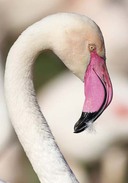
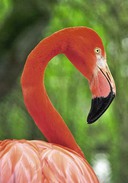
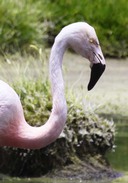
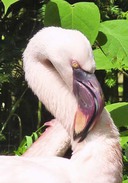
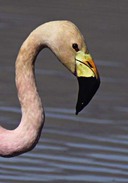
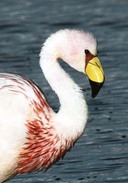
Common name
Greater flamingo
American/Caribbean flamingo
Chilean flamingo
Lesser flamingo
Andean flamingo
James’s/Puna flamingo
Body weight
2–4 kg
2.2–2.8 kg
Approx. 2 kg
Distribution11
Africa, Mediterranean, southwestern Asia
Caribbean, northern South America, Mexico, Galapagos
Southwestern South America; up to 4500 meters a.s.l.
East, West, and South Africa, South Asia
Peru, Bolivia, Chile, Argentina (high Andean plateaus and lower)
Peru, Bolivia, Chile, Argentina (high Andean plateaus and lower)
Red list cat. / Wild pop. size19
Least concern
500–700 x103
Least concern
Near threatened
300 * 103
Near threatened
2–3 * 106
Vulnerable
40 * 103
Near threatened
106 * 103

Unique Anatomy and Physiology
Special Housing Requirements
Reproduction
Feeding
Restraint and Handling
Anesthesia and Surgery
Physical Examination and Diagnostics
Phoenicopteriformes
Chapter 14

